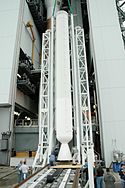Aerojet
| Aerojet | |
|---|---|
| Základní údaje | |
| Právní forma | akciová společnost a veřejně obchodovaná společnost |
| Datum založení | 19. března 1942 |
| Datum zániku | červen 2013 |
| Nástupce | Aerojet Rocketdyne |
| Zakladatelé | Frank Malina Martin Summerfield |
| Adresa sídla | Rancho Cordova, 957 42, USA |
| Souřadnice sídla | 25°21′37″ s. š., 80°33′52″ z. d. |
| Charakteristika firmy | |
| Oblast činnosti | letecký a kosmický průmysl |
| Produkty | raketový motor |
| Mateřská společnost | Aerojet Rocketdyne Holdings |
| Identifikátory | |
| Oficiální web | www |
| Některá data mohou pocházet z datové položky. | |
Aerojet byla americká firma zabývající se výrobou raketových motorů. V roce 2013 byla mateřskou společností GenCorp sloučena s Pratt & Whitney Rocketdyne za vzniku Aerojet Rocketdyne. Ústředí společnosti se nacházelo v Sacramentu v Kalifornii. Byla jedinou americkou společností, která vyráběla oba typy raketových motorů, na kapalné i pevné pohonné látky. Jejich produkty pokrývaly širokou škálu, od nejmenších manévrovacích motorů, hlavních motorů různých kosmických sond až po velké pomocné rakety Atlasu V. Produkty Aerojet lze nalézt téměř na všech balistických raketách používaných americkou armádou. Společnost se dále podílela na výzkumu hypersonických náporových motorů (scramjet) a iontových motorů. Jejími konkurenty na americkém trhu byly Rocketdyne (motory na kapalné pohonné látky) a Orbital ATK (motory na pevné pohonné látky).
Odkazy
Související články
- Aerobee – Sondážní rakety
- Aerojet General X-8 – Rakety stabilizované rotací
- Rakety Scout – Aerojet vyráběl první stupeň Algol
- Atlas V – Pomocné rakety Aerojet SRM
Externí odkazy
- (anglicky) Oficiální stránky
Média použitá na této stránce
KENNEDY SPACE CENTER, FLA. – On Launch Complex 41 at Cape Canaveral Air Force Station in Florida, the fifth and final solid rocket booster is raised to a vertical position. It will be lifted into the Vertical Integration Facility and added to the other four already mated to the Lockheed Martin Atlas V rocket there. The Atlas V is the launch vehicle for the Pluto-bound New Horizons spacecraft that will make the first reconnaissance of Pluto and its moon, Charon - a "double planet" and the last planet in our solar system to be visited by spacecraft. As it approaches Pluto, the spacecraft will look for ultraviolet emission from Pluto's atmosphere and make the best global maps of Pluto and Charon in green, blue, red and a special wavelength that is sensitive to methane frost on the surface. It will also take spectral maps in the near infrared, telling the science team about Pluto's and Charon’s surface compositions and locations and temperatures of these materials. When the spacecraft is closest to Pluto or its moon, it will take close-up pictures in both visible and near-infrared wavelengths. The mission will then visit one or more objects in the Kuiper Belt region beyond Neptune. New Horizons is scheduled to launch in January 2006, swing past Jupiter for a gravity boost and scientific studies in February or March 2007, and reach Pluto and Charon in July 2015.

